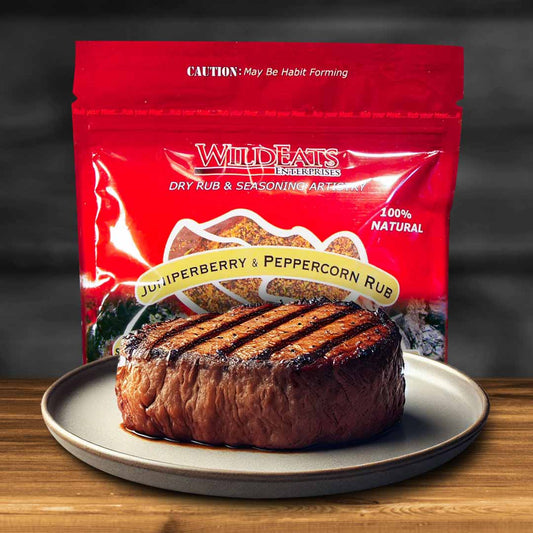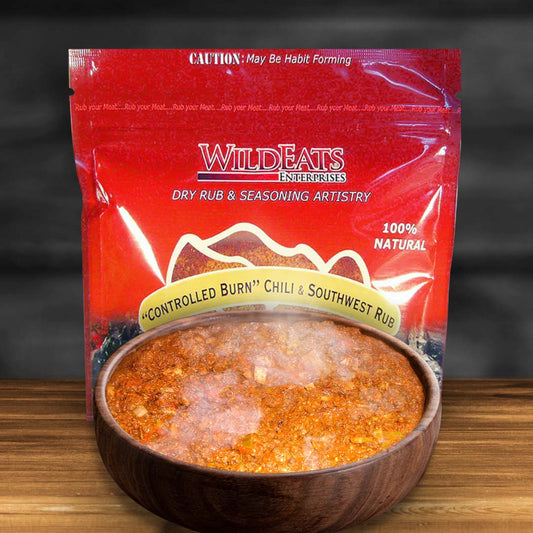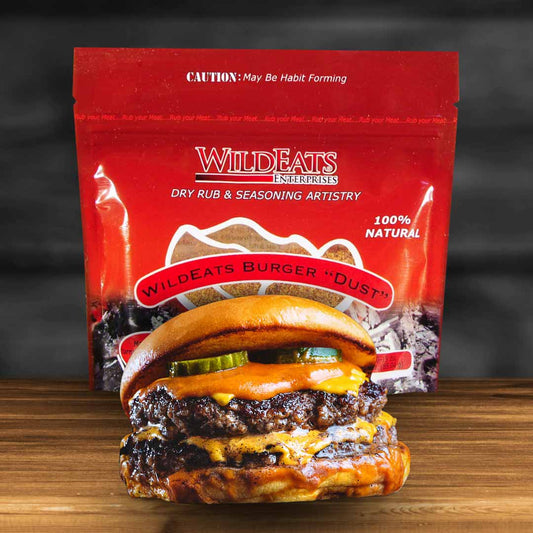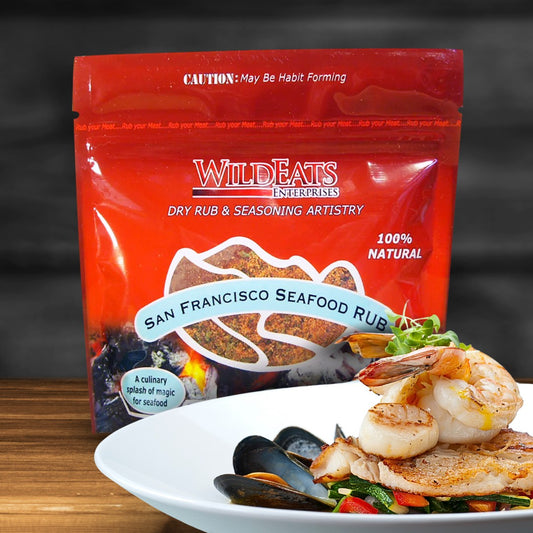WATERFOWL & DRY AGING
(dedicated to my longtime friend Mr. Patrick Gilligan)
THE answer to obtaining tender, juicy & delicate tasting birds
Waterfowlers - A more dedicated group of outdoorsmen you will not be able to find. This is, for many a year-round obsession. It starts with maintaining brooding ponds, clearing weeds and patching levees. It doesn’t stop with that either. There’s also the painting of decoys, practicing a wide variety of calls and getting the latest camo, gear and gadgets and making all the repairs on the trailers or camps, not to mention getting all those reservations for the refugees. All to be READY.

There are many styles of hunting waterfowl and there are just as many antidotes to prepare them for cooking. Waterfowlers, for as dedicated as they are about their pursuits are probably the biggest victims when it comes to accurate information about the proper handling of this often-misunderstood meat source. We have been pursuing these wonderful creatures for a very long time and many folks handle ducks and geese the way that they were taught or, as I have heard for years, “that’s the way we always did it.
I can’t begin to tell you how many people want to know, “how do I get rid of that gamey, muddy taste of my – ducks & geese. And “it always comes out tough” or worse “I love to hunt ducks and geese but boy oh boy I can’t get anyone to eat’em!” Well, we can address all those issues at one time.
The first thing we need to understand is what waterfowl are- they are the equivalent to Olympic athletes. When you think about it, all they do is migrate thousands of miles only to return a couple of months later. To say they are on a continuous exercise program would be the understatement of the year! Have you ever wondered why their muscles are so dark? Well, they have this process called “re-oxygenation,” it allows these birds to fly for hundreds of miles at a time. The reason they can achieve this is they have twice the amount of blood than most land animals. The extra blood adds oxygen to help keep their heart rate at manageable levels during these long flights. Contrary to this, are upland birds, which have very light-colored muscles, with minimal amounts of blood. When you flush a pheasant, they fly a couple of hundred yards and then they must land. The reason for this is the minimal amount of blood they have, and their heart rate accelerates, and they become easily fatigued.
So, waterfowl can fly for great distances, BUT that comes with a price – due to this abundant amount of blood their muscle tissue is very aggressive in flavor. When you consider that capillary blood found in muscle tissue is the broken-down byproducts of what that animal has consumed its easy to know why the meat is sometimes offensive. This is why that Mule Deer that has been feeding on sage for the past 7 years has a strong aggressive sagey flavor or the duck that has been feeding on aquatic plant life or small fish has a muddy or “liver” flavor. It is NOT “liver”, it is excess blood.
The only NATURAL way to breakdown this highly developed and very saturated muscle structure is “DRY AGING.” And this couldn't be more important to achieving the maximum potential with waterfowl.

Many outdoor people have heard of dry aging, but often associate this with big game animals or cattle. The finest restaurants in the world dry age their beef for 28 days which is complete overkill. These animals have never even broken into a trot no less fly at 10,000 feet for a hundred miles or like big game animals that run up and down high elevation mountains fleeing predators. Comparing domestic animals to wild game is like comparing an Olympic athlete to a couch potato.
Yes, I know there are thousands of myths and remedies for making your ducks and geese tender and eliminating the gamey, muddy flavor often associated with these creatures. And there are seasoning blends out there that will cover up just about anything! But there is a much more natural way to achieve better results and that is what we are looking for, RESULTS!
First off, just like there shouldn’t be a fishy flavor in fresh fish… there shouldn’t be any gamey flavor in game. A different richer flavor, yes but not gamey where it is offensive. If it is aggressive then several things could have contributed to that.
1. Your waterfowl wasn’t cleanly killed, and it was subject to stress, causing a tremendous adrenaline rush, thus filling the muscles with additional blood and endorphins. Which leave the meat in a very tough, stringy state.
2. After harvest cleaning was delayed to the point that the internal juices of the duck/geese started to spoil or taint the meat.
3. Your harvest was subject to warm temperature for too long, increasing bacterial growth. (bacteria growth is greatest between 45°F – 140°F)
4. Your freezing/defrosting procedure was improperly handled
5. Your harvest was consumed “at too fresh a state.” – This is what we will cover.
When you think of the progression of events when waterfowl hunting it becomes clear why most of us don’t enjoy our harvests to their maximum potential.
1. We hit the blinds at first light.
2. Hopefully by mid morning we have our limits.
3. We head back to the club/trailer etc, probably have a bite to eat, and eventually clean our birds.
4. They are wrapped up in a variety of ways and placed into a freezer. This is usually done in a matter of hours.
5. At some point they are removed from the freezer with the anticipation of a fine meal.
I believe this is more than likely the chain of events leading up to your meal preparations. The problem is that these birds are way too fresh and still full of their natural moisture - blood/water etc. This moisture is what maintains the natural structure of their muscle tissue. The fibrous tissues give these animals the strength to cover enormous tracks of land and sea. It is also the cause for toughness and aggressive flavor in their meat. The only way you can naturally breakdown these tissues is to deprive them of moisture. Without this moisture these fibers begin to break down, thus yielding a tender, delicate piece of meat. This is true with all meat, especially game meats. Most of us have heard the term “dry aged” used with big game meat or cattle but seldom think about it with regards to waterfowl. And we should!
What happens during this process is a slow evaporation of the internal moisture of these muscles, this moisture is what maintains the tough fibers. At the same time, you’re draining off the excessive blood. Blood is responsible for a good portion of the aggressive flavors associated with wild game meats. This is the primary cause for aggressive flavor in your meat. Get rid of the blood and you'll have a delicate tasting duck or goose. Get rid of the internal moisture and that same piece of meat will be tender. Its that simple!

All you need to accomplish this is –
1. A tray or large roasting pan enough to hold all you birds
2. A screen or rack that will keep the meat from sitting in its blood
3. A refrigerator
4. Time and patience!
This process can be done before the birds are frozen (right after the hunt) or, as needed as you take them from the freezer. It doesn't matter when it happens, just that it happens. Most of us don’t have the convenience of a large walk-in refrigerator big enough to hold many birds. So, I recommend re-introducing the dry aging process after your birds have been defrosted, piece by piece! All it takes is a little organizational discipline. Take your wrapped birds and place it on a plate or tray in the refrigerator. Leave the wrapper intact. We want to slow the defrosting process down as slow as possible. This will allow the meat to retain its natural juices. To completely defrost the average sized package will take about two days. When it is totally thawed out remove the wrapper. Discard the blood that has accumulated. I prefer to freeze my birds' whole and age them split down their backs with the cut side down on the rack. This way the blood has plenty of places to drain from. Dry off the birds and place them onto the rack. Place the rack on a tray that will catch the draining blood. Place the tray/rack into the refrigerator, uncovered. Make sure there is good air circulation around the meat.
Recommended Dry Aging time for Red Meat Birds
Doves/Band-tailed pigeons 1-2 days
Teal (sm. ducks) 1-2 days
Widgeon (med. ducks) 2-4 days
Sprig/Mallards (lg. ducks) 4-7 days
Specks/Snow Geese 7-10 days
Honkers 10-14 days

You may want to do this in the downstairs frig. as your wife might not be too happy with a bunch of ducks bleeding in her frig. However, she WILL be very happy with the results!
The color of an aged waterfowl will go from an eggplant purple color to the color of a piece of veal. You can tell if your birds are aged enough by squeezing the breast meat with your fingers. If the meat yields to the pressure, it means the fibrous tissues are broken down and it is ready. If it feels rubbery and bounces back, it might need a little longer. Once you have Dry Aged your birds, and trust me once you do this, you'll never handle your birds any other way, I recommend boning the breasts out trim off most of the fat. Also remove the fat from the carcass. Save the fat, place that into a heavy gauged pot with a little water. Cover and place on a stove over low heat to render the fat. Stir occasionally until the fat liquifies. Strain and reserve for later use for sauteing, frying or poaching the legs for confit.

Save all the legs for additional applications like meatballs, soups, chili, bolognaise or our Famous Confit!

Chop all the carcasses into uniform pieces, rinse with cold water and place on a roasting pan with carrots celery and onions and roast until golden brown. Place in a large stock pot, cover with cold water and simmer for 4-5 hours. Strain and use for several applications like reducing to make demi-glace.
Behind Every Good Sauce Is a Solid Foundation
The true test to any good cook is the quality of his/her sauce and although the glamour belongs to the final finished sauce, it owes all the credit to the often-overlooked stock. The only way to obtain a good stock is to extract flavor (proteins and nutrients) from bones. The difference between a stock and a broth is stocks are made from bones and broths are made from meat.
There are two different kinds of stock a light stock or a dark stock. Light (or white stocks) are used to create white or clear sauces/soups. Dark stocks are used to make dark sauces or reductions like demi-glace. Demi-glace is the reduction of stock that has been fortified with vegetables, herbs and wine reductions and is reduced to a very rich consistency. For one quart of demi-glace you would have to start with about 5 qts. of dark stock. This sauce is slowly simmered and cleaned (skimming off the fats, oils and scum that forms on the simmering liquid) for hours. This reduction intensifies the flavor of the stock through evaporation. The final demi-glace sauce adds a touch of refined luxury and decadents to meat dishes and is much easier than you might think. It just takes some time…and the smells…. oh, the smells!
Dark (brown) Stock
8 -10 lbs. chopped duck/goose bones cut into small pieces
Use fresh or previously frozen bones.
5 - 6 qts. cold water
2 lbs. onions, celery, carrots - classically referred to as - mire poix
(50% onions, 25 % celery, 25% carrots)
4-6 oz. tomato product (like diced tomato)
2 Bay leaves
1 bunch parsley stems
1 tbsp crushed black peppercorns
1 tbsp dried thyme or ½ bunch fresh thyme
1 bulb fresh garlic chopped rough
Cut the bones as small as you can and wash them with cold water to remove any blood. Season them with salt and pepper, place in a roasting pan and roast in a hot oven (400°) until golden brown, Apr. 1 hour. Remove the bones from the roasting pan and place them in an appropriate stock pot. Drain the fat from the roasting pan and add a little water (or wine) to remove the residue from the bottom of the pan. Scrape this into your pot with the bones. This essence has a great flavor and will add good color to your stock. Cover the bones with the water and bring to a boil. Skim the scum that forms on the top of the water, try to keep the stock as clean as possible throughout the cooking process. Turn the heat to a slow simmer, about 180°F and add a little ice or very cold water to the stock. This will allow the stock to clear itself once more. The clarity of your stock is a good indication of how much of the impurities have been removed. Impurities cloud the pure flavor of your stock. A true chef prides him/herself on how clear their stocks are. After the stock has simmered for about 1 hour, add the mire poix, sachet and tomato product. (For an extra burst of flavor - brown the mire poix in a pan with the herbs and tomato product before adding it to your stock.)
Continue to simmer for an additional 1 - 4 hours. Strain through the finest strainer you have and cool as fast as possible, this will insure a long shelf life (or freezer life). This technique is used for all stocks.
The following is the required cooking times for the individual stocks. They should be used as general guidelines.
Total Cooking Time
The actual times will vary with volume of product being used
Chicken or Fowl, 3 - 4 hours
Beef, Veal or Game, 4 - 6 hours
Vegetable – 1-2 hours
To obtain a white stock simply place the bones and vegetables (mire poix) in a stock pot and bring to a simmer. Just remember to practice the same cleaning process as with the brown stock.
I pack my stocks in qt sized Zip-lock bags and have them in my freezer for whenever I want to whip up some healthy soups, sauces or use to cook my favorite stew or pot roasts.
Cabernet Demi-Glace
4 tbsp fine diced shallots
2 tbsp minced fresh garlic
4 tbsp clarified butter, olive oil OR my favorite clarified duck fat
4 tbsp flour
2 cups good quality cabernet wine
4 qts. Dark beef, game or veal stock
salt and pepper to taste
To finish
½ cup cold butter cut into small pieces
herb garnish - thyme, sage, marjoram, chives, scallions
Add clarified butter or olive oil to a stock pot. Turn on the heat to medium. When the fat is hot add the garlic and shallots, stir until lightly golden brown. Add the flour and stir for several minutes until the flour starts to turn brown. Add the red wine and mix thoroughly. You don’t want any lumps. Cook for a couple of minutes until the wine reduces by half. Add the cold stock and again mix thoroughly. Slowly bring the stock to a simmer and skim any scum that forms. Allow the stock to reduce for several hours or until it’s about 2/3 reduced. The sauce should be slightly thickened and have a brilliant shine. Using a wire whip stir the butter into the sauce. This will thicken the sauce a bit and add more shine. At this point you can strain the sauce or use as it is. Adjust the seasoning with salt and pepper and add whatever herbs you like. This last step should be done just before serving so the herbs retain their color.
Roasted Apricot Gastrique
24 ripe summer Apricots - cut in half, pit removed
1/2 cup sugar
1 cup champagne vinegar (or your own favorite)
2 tbsp shredded fresh ginger
2 cups orange juice
1/2 tsp crushed red chili flakes
juice & zest of 1 lemon
Salt to taste
2 oz. good quality cognac, brandy or bourbon
splash of orange flower water (optional) you can find this in Middle Eastern markets or in some higher end liquor stores
other optional additions – truffle oil or foie gras if you really want to get sexy

Place all the apricots on a parchment lined sheet pan and into a 300° F oven for about 20 minutes. You want the apricots to slightly roast without color. Remove them from the oven when they are soft to the touch. While you're roasting your apricots, place everything else except the cognac, salt and orange flower water into a non-corrosive sauce pot and bring it to a simmer. Once it simmers add the roasted apricots. Turn the heat down to low and slowly simmer for another 30 minutes or so. Allow the mixture to cool slightly anand then place it into a blender. Process until smooth - It should be the consistency of yogurt, adjust with additional orange and lemon juice. Adjust the seasonings and add the cognac and orange flower water. I like to strain it threw a fine sieve, and that's what gives it a velvetvelvety texture. You can store in your refrigerator for 2 weeks or place it in the freezer indefinitely.
A little sweet, a little tart, a little spicy, a little acidic.... all the components that match up with all those full-flavored game meats we love... ENJOY
It does take some work but that’s the fun part of cooking. Sharing your discoveries with your friends and family is a great gift.
Dry Aging, although timely, will give you results you never thought possible This process gives you the best of both worlds, tender and mild. If you thought your favorite waterfowl recipe was good before…wait until you try it with an aged piece of meat!
You’ve worked very hard for your harvests, enjoy them to their maximum potential. I can’t tell you how many dinner guests of mine at VOM where amazed at the tender, subtle flavors of our famous Duck dinner.
Your guests will be just as amazed.

HERE’S TO YOU PAT!









1 comment
John has the best spice mixes and As a fellow CIA alum the following phrase says it all about the passion of cooking It does take some work but that’s the fun part of cooking. Sharing your discoveries with your friends and family is a great gift.